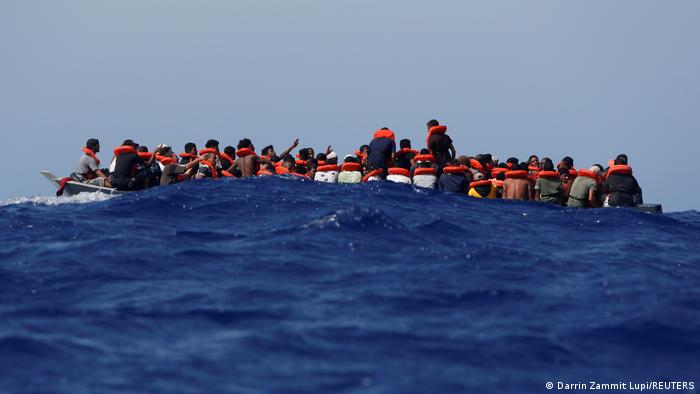
"I decided to go to Libya when my father died a few years ago. I was the only person of the eight-member family and I had to do something to maintain the family," Lakuira Sobuj, a Bangladeshi migrant who came to Italy last year after crossing the Mediterranean from Libya, told InfoMigrants.
The 25-year old Bangladeshi citizen spent around €4,000 to go to Libya in 2020, which was his primary destination for work. He was not planning to come to Europe at that time.
"My family is impoverished. My mother works as a housemaid in our village in the central Bangladeshi district of Shariatpur. I had to sell our cow and take some loans to go to Libya," he recounted.
Sobuj, who didn't go to school as a child because his family was so poor, was employed as a construction worker for a few months in the Libyan city of Benghazi. But he was beaten when he asked for his wages. So Sobuj decided to make the dangerous boat journey from Libya towards Italy for a better life.
Maritime crossings
"We spent around 24 hours on a boat to cross the Mediterranean to reach Italy's Lampedusa island on February 21, 2021. There were 93 people on the boat, over 40 of them were my fellow countrymen," he said.
Sobuj has been living at a migrant center in Italy's capital Rome since then. His dream of getting a job in the European country is yet to be fulfilled.
"I had to pay another €2,000 to a human trafficker in Libya for my journey to Italy ... But I'm still unemployed here. I don't know anyone here. Nobody has offered me a job. My mother still works as a housemaid back home," he told InfoMigrants. "I don't know what is waiting for me in the future."
With a GDP of over $409 billion (€362 billion), Bangladesh currently has the world's 37th largest economy. Forecasts suggest the size of the economy could double by 2030.
But even though the South Asian country has become one of the world's fastest-growing economies, thousands of its citizens still try to to come to Europe in the hopes of a better and more secure life.
Annual statistics published by the EU's border agency Frontex show that at least 8,667 Bangladeshi citizens entered the block last year irregularly. Of that group, 7,574 came via the central Mediterranean route, 604 via the eastern Mediterranean and 437 via the western Balkans.
Bangladesh is second in Frontex' list of countries whose citizens take the dangerous central Mediterranean route connecting Libya and Italy.
Last month, seven Bangladeshis died of hypothermia while trying to reaching Lampedusa from Libya. Such casualties are regular on this route.
Italy most popular
Frontex statistics also suggest that most Bangladeshi migrants who entered the EU irregularly last year ended up in in Italy. It has remained the favored destination for many Bangladeshis over the past few decades.
Arafat Rahman, a Bangladeshi migrant who came to Serbia last year with a seasonal worker visa, told InfoMigrants that his ultimate destination was Italy.
"I have already spent thousands of euros to find a way to reach Italy from Serbia. And, I'm hoping to make it possible soon," he said.
Rahman said that Bangladeshi human traffickers who live in Serbia ask for between €4,000 and €6,000 per person to smuggle somebody from Serbia to Italy.
"The safest way to make the journey is getting into a lorry that goes to Italy from Serbia. But you need to pay a lot of money to traffickers to make it happen," Rahman said. "Other ways include crossing the borders on foot, which is risky but less expensive."
Rahman hasn't made that journey yet. He's ended up living at a migrant center in Serbia after a people smuggler stole his money and threatened to kill him if he tried to complain to the local police.
"I came to Serbia with the hope to reach Italy after failing to get a job as a computer operator at a court in Bangladesh," Rahman said.
He was told that if he wanted the job, which paid €160 a month, he would need to pay a bribe of €16,000.
"I decided not to take the job as the bribe was too high," Rahman explained. "I could earn much more in Italy and pay back the loan that I took to come here."
"Around 150,000 Bangladeshi migrants live in Italy. They are employed in various sectors, including agriculture, shipbuilding and street trading," Shameem Ahsan, Bangladesh's ambassador to Italy, told InfoMigrants.
No other EU country has that many Bangladeshi immigrants. The diplomat thinks that Italy has a more welcoming attitude towards foreigners. It also legalizes irregular migrant workers occasionally.
"There has been a public perception that Italy is very lenient towards foreigners. That's why many people believe that they will get legal status at some point after somehow entering the country using different routes," Ahsan explained.
No legal routes
The Italian government has made it possible to hire workers from Bangladesh in "seasonal" and "non-seasonal" categories from 2020 onwards.
According to a circular distributed by the Bangladeshi embassy in Rome last month, Italy will issue 69,700 visas for 31 non-EU countries, including Bangladesh, this year.
"Bangladeshi migrants should try to come to Italy by legal means," Ahsan continued, noting that Bangladesh had signed onto an EU agreement that meant illegal migrants could be deported faster.
Coming legally is not easy though.
"Only 3,500 Bangladeshi migrants will be able to come to Italy under the recent circular. It's a tiny number compared to the hundreds of thousands of people interested in coming," Palash Rahman, a Bangladeshi journalist based in the Italian city of Venice, said.
"We need to create more legal opportunities for Bangladeshi workers," he concluded.
InfoMigrants is a news and information site for migrants to counter misinformation at every point of their journey. It is a collaboration led by France Médias Monde, Deutsche Welle and Italian press agency, ANSA.